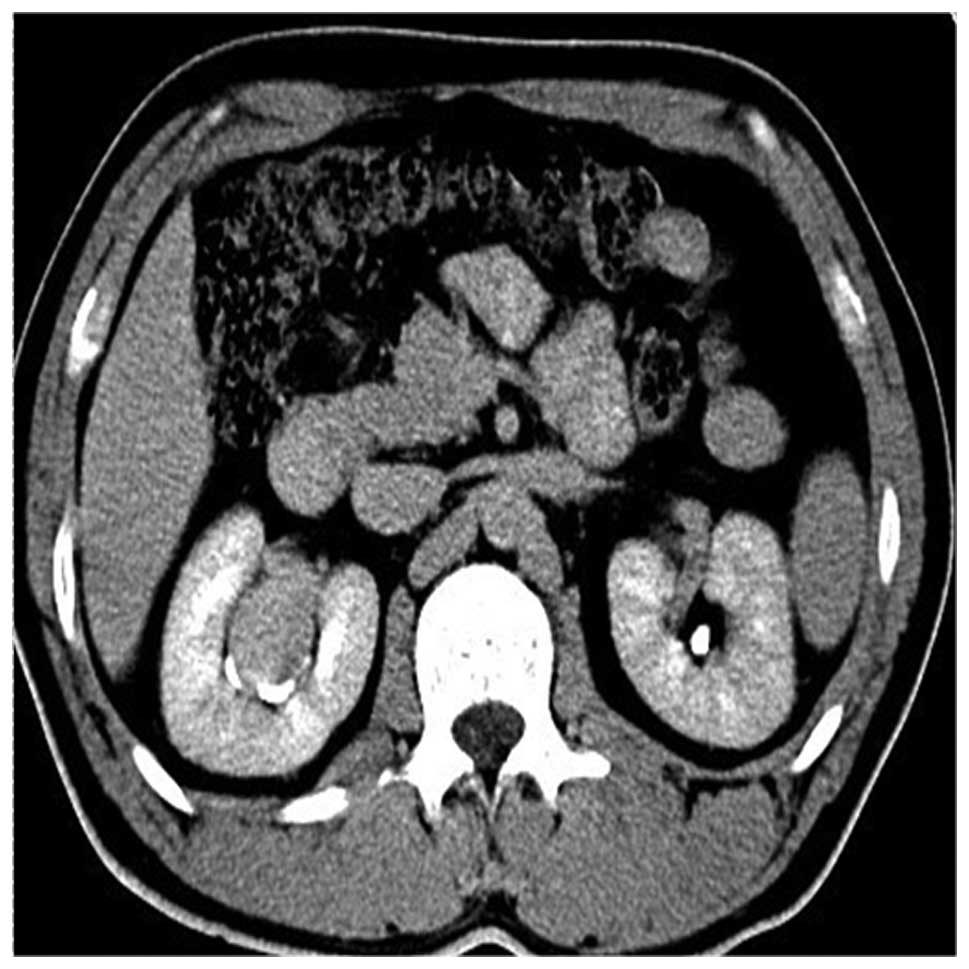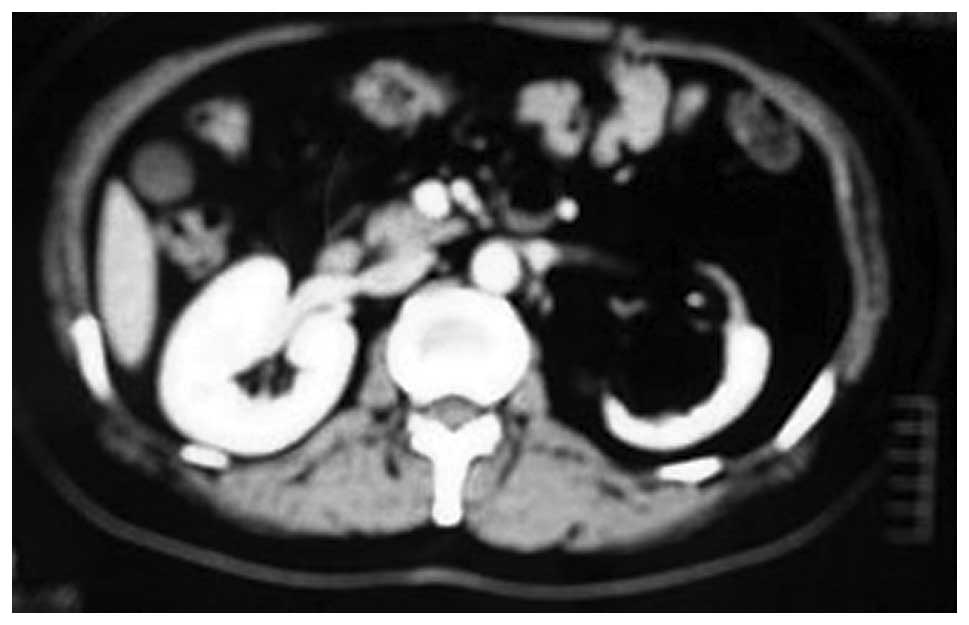|
1
|
Amin MB, Tickoo SK and Schultz D:
Myelolipoma of the renal sinus: an unusual site for a rare
extra-adrenal lesion. Arch Pathol Lab Med. 123:631–634.
1999.PubMed/NCBI
|
|
2
|
Gupta NP, Kumar P, Goel R and Dinda AK:
Renal sinus hemangioma simulating renal mass: a diagnostic
challenge. Int Urol Nephrol. 36:485–487. 2004. View Article : Google Scholar
|
|
3
|
Matsushita M, Ito A, Ishidoya S, Endoh M,
Moriya T and Arai Y: Intravenous extended liposarcoma arising from
renal sinus. Int J Urol. 14:769–770. 2007. View Article : Google Scholar : PubMed/NCBI
|
|
4
|
Akaza H, Koiso K and Niijima T: Clinical
evaluation of urothelial tumors of the renal pelvis and ureter
based on a new classification system. Cancer. 59:1369–1375. 1987.
View Article : Google Scholar : PubMed/NCBI
|
|
5
|
Mazairac AH and Joles JA: Renal sinus
adiposity and hypertension. Hypertension. 56:814–815. 2010.
View Article : Google Scholar : PubMed/NCBI
|
|
6
|
Lopez-Beltran A, Scarpelli M, Montironi R
and Kirkali Z: 2004 WHO classification of the renal tumors of the
adults. Eur Urol. 49:798–805. 2006. View Article : Google Scholar : PubMed/NCBI
|
|
7
|
Metro MJ, Ramchandani P, Banner MP, et al:
Angiomyolipoma of the renal sinus: diagnosis by percutaneous
biopsy. Urology. 55:2862000. View Article : Google Scholar
|
|
8
|
Diamond A, Kodroff M and Ravitz G: Renal
sinus angiomyolipoma. Urology. 9:221–223. 1977. View Article : Google Scholar : PubMed/NCBI
|
|
9
|
Carcamo Valor P, Martínez-Piñeiro JA,
López-Tello J, Picazo García M and Contreras Rubio F:
Hemangiopericytoma of the renal sinus: report of a case and review
of the literature. Arch Esp Urol. 49:944–949. 1996.(In Spanish).
PubMed/NCBI
|
|
10
|
Yoshida M, Inoue S, Yanagisawa R, Kishi H
and Takahashi M: A case of multiple renal leiomyoma located at
renal sinus and hilus. Hinyokika Kiyo. 36:937–940. 1990.(In
Japanese). PubMed/NCBI
|
|
11
|
Johraku A, Miyanaga N, Sekido N, et al: A
case of intravascular papillary endothelial hyperplasia (Masson’s
tumor) arising from renal sinus. Jpn J Clin Oncol. 27:433–436.
1997. View Article : Google Scholar
|
|
12
|
Shimazui T, Nutahara K, Ishii Y and Horibe
Y: A case of malignant paraganglioma within the renal sinus.
Hinyokika Kiyo. 31:2027–2033. 1985.(In Japanese). PubMed/NCBI
|
|
13
|
Honda H, Lu CC, Franken EA Jr, Bonsib SM,
Yuh WT and Williams RD: Renal sinus malignant lymphoma: a case
report. J Comput Tomogr. 12:190–192. 1988. View Article : Google Scholar : PubMed/NCBI
|
|
14
|
Yaman O, Soygür T, Ozer G, Arikan N and
Yaman LS: Renal liposarcoma of the sinus renalis. Int Urol Nephrol.
28:477–480. 1996. View Article : Google Scholar : PubMed/NCBI
|
|
15
|
Chaabouni MN and Mhiri MN: Pseudotumoral
lipomatosis of the renal sinus. Ann Urol (Paris). 27:93–96.
1993.(In French).
|
|
16
|
Katabathina VS, Vikram R, Nagar AM,
Tamboli P, Menias CO and Prasad SR: Mesenchymal neoplasms of the
kidney in adults: imaging spectrum with radiologic-pathologic
correlation. Radiographics. 30:1525–1540. 2010. View Article : Google Scholar : PubMed/NCBI
|
|
17
|
Drewniak T, Rzepecki M, Juszczak K,
Moczulski Z, Reczyńska K and Jakubowska M: Methodology and
evaluation of the renal arterial system. Cent European J Urol.
66:152–157. 2013.
|
|
18
|
Shetty A and Adiyat KT: Comparison between
helical computed tomography angiography and intraoperative
findings. Urol Ann. 6:192–197. 2014. View Article : Google Scholar : PubMed/NCBI
|
|
19
|
Carvalho JC, Thomas DG, McHugh JB, Shah RB
and Kunju LP: p63, CK7, PAX8 and INI-1: an optimal
immunohistochemical panel to distinguish poorly differentiated
urothelial cell carcinoma from high-grade tumours of the renal
collecting system. Histopathology. 60:597–608. 2012. View Article : Google Scholar : PubMed/NCBI
|
|
20
|
Kamath A, Rosenkrantz AB and Bosniak MA:
MRI findings of angiomyolipoma of the renal sinus in 5 cases. J
Comput Assist Tomogr. 34:915–920. 2010. View Article : Google Scholar : PubMed/NCBI
|
|
21
|
Moch H, Artibani W, Delahunt B, Ficarra V,
Knuechel R, Montorsi F, Patard JJ, Stief CG, Sulser T and Wild PJ:
Reassessing the current UICC/AJCC TNM staging for renal cell
carcinoma. Eur Urol. 56:636–643. 2009. View Article : Google Scholar : PubMed/NCBI
|
|
22
|
Kuzaka P, Pastewka K, Faryna J, Kuzaka B,
Pypno W and Wejman J: Nested variant of urothelial carcinoma of
renal pelvis-a case report. Pol J Pathol. 65:74–77. 2014.
View Article : Google Scholar : PubMed/NCBI
|
|
23
|
Lin Z, Chng JK, Chong TT and Soo KC: Renal
pelvis squamous cell carcinoma with inferior vena cava
infiltration: Case report and review of the literature. Int J Surg
Case Rep. 5:444–447. 2014. View Article : Google Scholar : PubMed/NCBI
|
|
24
|
He YF, Chen J, Xu WQ, Ji CS, Du JP, Luo HQ
and Hu B: Case report. Metastatic renal cell carcinoma to the left
maxillary sinus. Genet Mol Res. 13:7465–7469. 2014. View Article : Google Scholar : PubMed/NCBI
|
|
25
|
Ambrosio MR, Rocca BJ, Onorati M, Bellan
C, Barbanti G, del Vecchio MT and Tripodi S: Renal sinus
pseudolymphoma in a patient with multiple carcinomas: a case report
and a brief review of the literature. Histol Histopathol.
27:1327–1332. 2012.PubMed/NCBI
|
|
26
|
Shirotake S, Yoshimura I, Kosaka T and
Matsuzaki S: A case of angiomyolipoma of the renal sinus. Clin Exp
Nephrol. 15:953–956. 2011. View Article : Google Scholar : PubMed/NCBI
|
|
27
|
Choi YJ, Hwang TK, Kang SJ, Kim BK and
Shim SI: Hemangiopericytoma of renal sinus expanding to the renal
hilum: an unusual presentation causes misinterpretation as
transitional cell carcinoma. J Korean Med Sci. 11:351–355. 1996.
View Article : Google Scholar : PubMed/NCBI
|














